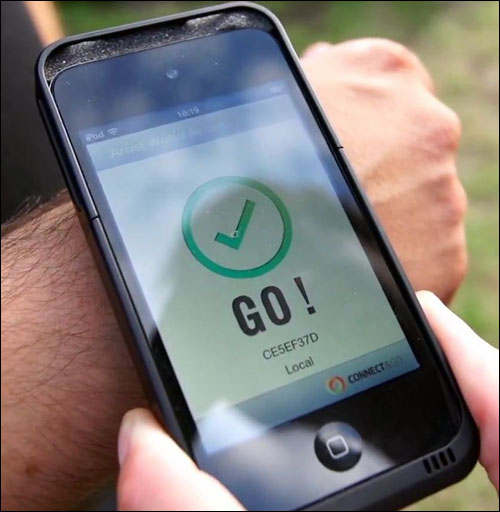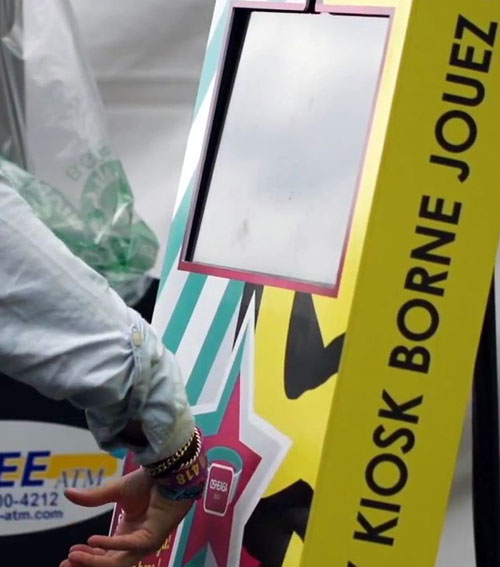When the three-day Osheaga Music and Arts Festival begins this summer, everyone onsite will be wearing a wristband containing a passive 13.56 MHz RFID tag, including performers, member of the press, the event crew and the 45,000 anticipated attendees. In fact, the wristband will act as the ticket for audience members, and will grant access to specific areas of the event. The solution was first installed at last year’s Osheaga festival by music promoter evenko—which, according to Michael Rodrigues, evenko’s ticketing manager, not only will supply the same system again this year, but will also provide it for the first time at Heavy Montreal, another music festival taking place at the same site the following weekend.
Osheaga Festival is held for three days each August at the Parc Jean-Drapeau, located in Montreal. It hosts indie bands—such as The Cure, Jack White, and Mumford and Sons—on six stages, and hosts approximately 45,000 people per day, for a total of 135,000 throughout the long weekend. Several years ago, evenko, which produces a variety of events throughout eastern Canada and northeastern United States, began looking into a more efficient access-control system, such as those used at other festivals that employ RFID-enabled wristbands, to better manage the flow of people around the event.

“We keep getting bigger,” Rodrigues said, regarding the Osheaga festival, while addressing an audience at this year’s RFID Journal LIVE! conference and exhibition, held last month in Orlando, Fla. During his presentation, he described the Near Field Communication (NFC) RFID solution deployed last year, as well as evenko’s plans for the two festivals being held in summer 2014. For Osheaga, evenko required technology to enable reduced queuing and improved management of which individuals had access to which areas. However, Rodrigues said, access control was not the festival’s primary concern; instead, the promoter sought other benefits from an RFID system, such as enabling ticket holders to connect with social media, potentially promoting not only bands and the event itself, but also products that could advertise via social media. Evenko also wanted to obtain analytics indicating which demographics liked which features of the festival.
To accomplish this goal, the company wanted to use the technology to get to know ticket holders more personally. This could be done by inviting them to input information about themselves while purchasing a ticket online, such as their age, gender and musical interests, and then gaining more data regarding those interests as the guests used the NFC readers at kiosks located around the festival to indicate where they were and which bands interested them.
Prior to the RFID system’s deployment, Osheaga’s knowledge was limited to how many tickets had been purchased—it knew virtually nothing about the ticket holders themselves. Everyone onsite was given color-coded bracelets to indicate where they were authorized to go, but this system was often confusing for personnel and yielded no historical data.
Last year, Osheaga introduced the NFC bracelets to manage social-network connections, associated analytical data and access control. Evenko deployed the solution with help from RFID Academia, which provided strategic marketing and technology consulting services throughout the deployment, says Anthony Palermo, RFID Academia’s founder and business-development director.
“We helped them see their vision through to a real-world deployment,” Palermo says. RFID Academia’s spinoff company, Connect&Go (a joint venture between RFID Academia and social-media and mobile-marketing firm Piranha), provided the hardware, software and onsite services required. The solution included ID&C NFC RFID wristbands; Connect&Go’s NFC readers, access-control platform and social-media platform; and Marcato Festival data-management software that interpreted data from each wristband read, which it then forwarded to the Osheaga festival’s ticketing software.
For access control, certain staff members were each equipped with an Apple iPod Touch mounted on a Wireless Dynamics‘s iCarte 420 NFC reader, which locks onto an iPod Touch or iPhone and can be plugged into the handset’s bottom connector. Kiosks, such as photo booths that sent pictures or data to a user’s social-network accounts, had built-in, custom-made Connect&Go NFC RFID readers. Altogether, there were approximately 100 RFID readers in use at the 2013 event, and about 150 will be used this year.

For visitors, Rodrigues said, just getting used to the system required some education, since attendees sometimes did not understand that the wristband served as the ticket. Evenko also had to determine the best process to ship bracelets to users; ultimately, the company had specific envelopes made.
Evenko established a Web-based system known as Osheaga Play, used both last year and this year, to launch the ticket holder’s experience. Using the site, a festival client can sign up, receive information about the event and create his or her own profile for the show. “If you want to interact with the site, you would have to create a profile,” Rodrigues says, and that acts as an incentive to get people comfortable with the system. For example, he adds, users would need to use a social-media site or sponsor activation to sign up to win a prize. They could also download a mobile application for their smartphone in order to obtain festival schedules and instructional videos.
As attendees arrived at the gates to last summer’s festival, evenko personnel used the NFC-enabled iPods to read each guest’s wristband tag, allowing that person to enter, while also creating a record of who had arrived. While walking throughout the grounds, attendees could utilize the read stations to “like” a band on Facebook, or to share information or pictures via social media. At last year’s event, there were 23,559 such interactions, with 23,000 ticket holders linking to social media, and links to 12.5 million Facebook friends.
Analytics derived from data retrieved last year by the Osheaga Play system indicated that 65 percent of attendees were female, with 88 percent between 18 and 34 years old. Sixty-seven percent had studied at a college level. It also found that 65 percent were tourists, with the remainder comprising Montreal locals.
The system not only increased the visibility of the festival and its sponsors on social media, but also helped evenko get to know its clients—the event’s audience.
Last year, evenko installed more than 75 accreditation checkpoints (typically, employees manning a gate with an NFC-enabled iPod), where workers could validate whether someone was authorized to enter a specific area. That data was then transmitted to the back-end software via a Wi-Fi network. One of the greatest challenges last year, Rodrigues said, was ensuring that there were enough Wi-Fi access nodes to collect data from the NFC readers within a park filled with people, and containing a high amount of metal and a large wooded area with lakes. “Running cable was an undertaking,” he stated. “You have to take a look at where you need boosters, where you can run cables, etc.”
With the technology in place, employees had the ability to access a particular client’s profile via his or her NFC-enabled iPod and make changes as necessary, such as removing or adding an access area to that individual’s profile. This decreased the need for ticket holders or personnel to go to the office or kiosk to make a change, thereby reducing queue lengths.
Next, Rodrigues told LIVE! attendees, evenko intends to further boost the park’s Wi-Fi presence by installing additional Wi-Fi nodes, while the software is being adjusted to enable more flexible functionality. “The first year, you never really know what to expect,” he said, adding that for the upcoming event, “We have the reality of what actually happened, and it was very positive. This year, we want to take that system and make it more flexible and more reliable.”
Evenko hopes to leverage the technology in other ways as well, such as linking NFC bracelets to prepaid accounts, to eliminate the need for cash or credit cards. “We’re looking hard at cashless payments,” Rodrigues said, “but we want to do everything right.” That, he noted, means ensuring that no mistakes are made with a prepaid account system. “If we give you [the client] a bad experience, it will be very hard to convince anyone to participate. This is their money we’ll be working with, and we want something that’s safe.”
In the long term, evenko is also investigating the possibility of utilizing NFC-based smartphones as tickets. What’s more, the company might also opt to encode each ticket holder’s data on his or her bracelet tag, in order to ensure that all user information linked to that bracelet could be accessed onsite—even if the Wi-Fi network were temporarily out of service.


